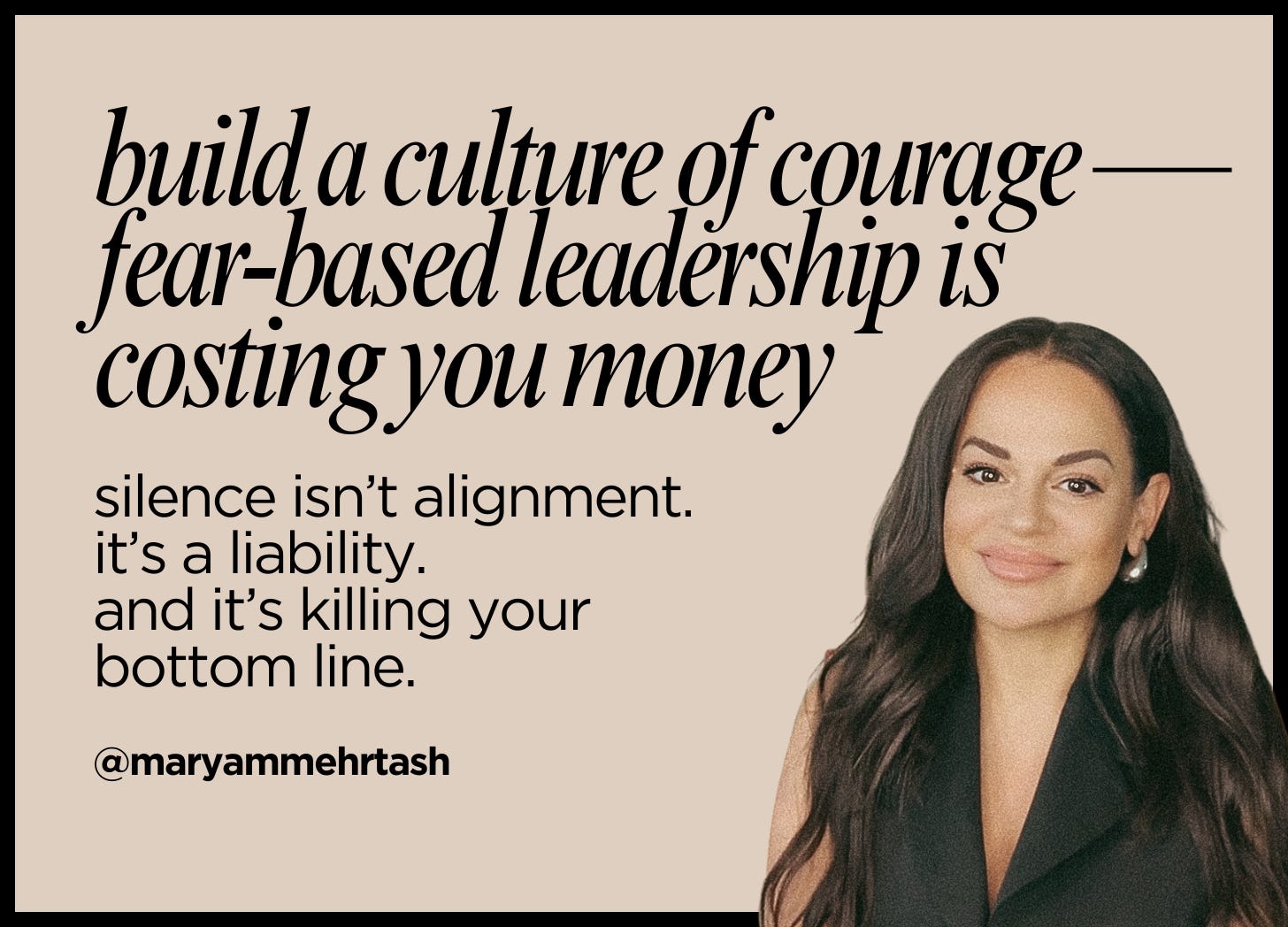Build a Culture of Courage — Fear-Based Leadership Is Costing You Money
Silence isn’t alignment. It’s a liability. And it’s killing your bottom line.
Have you ever been in a meeting where everyone is quietly glancing around, hoping someone else will say the thing no one wants to say?
And then, finally, one brave soul speaks up. Maybe awkwardly. Maybe with hesitation. Maybe not even directly. But the truth is in the air now. And suddenly, the room stiffens. That person is left hanging. The colleagues who privately agreed moments earlier fall silent, then start Slacking each other in hushed disbelief. The message is clear: say the hard thing, and you stand alone.
I’ve been that brave soul. One too many times.
Not because I wanted to be disruptive. But because I knew what I had to say could improve the outcome. Could protect the business. Could save the company from a mistake.
But too many people, especially junior employees, stay silent in front of leadership. Why? We’re paid for our expertise and opinions, yet fear-based cultures make speaking up feel like a risk. In many workplaces, speaking up isn’t rewarded. It’s punished, subtly or overtly. Fear-based leadership might look clean on the outside, but underneath, it’s running on suppression, not strategy. And that suppression is expensive.
It all comes down to culture. Fear-based leadership is costing companies billions, and it’s time to confront it.
The Hidden Cost of Fear
Fear-based leadership doesn’t always come with yelling or micromanagement. Sometimes, it’s more covert: the boss who shuts down dissent with a smile. The “open-door policy” that leads to quiet retaliation. The reward systems that prize compliance over creativity.
You think you're being efficient.
You think pressure breeds performance.
You think silence equals alignment.
But fear actually creates:
Passive teams who stop offering ideas and start playing safe.
Bad decisions made in echo chambers instead of with real input.
Risk-averse cultures where no one dares to try something bold.
High turnover as your best people quietly opt out.
Innovation bottlenecks as ideas are filtered before they even form.
Burnout, the quiet kind, from people carrying too much and saying too little.
When people don’t feel safe to speak up, they stop participating altogether.
And that silence? It’s not neutrality. It’s a financial liability.
Here’s the evidence:
A 2023 study from Love Leadership and First & First Consulting, LLC found that one-third of corporate managers lead with fear, costing U.S. companies $36 billion annually in lost productivity. That’s 10 hours of productivity lost per leader, per week, or $29,000 per leader each year (WorkLife, 2023).
In Australia, the same pattern holds. Fear-based leadership costs an estimated $2.3 billion annually in productivity loss (HR Leader, 2023).
High turnover from toxic cultures isn’t cheap either. Research shows that replacing one employee costs 50–60% of their salary—and even more for senior roles (Forbes, 2015).
And the human toll? A survey found that 60% of employees under fear-driven managers are unhappy at work (HR Dive, 2023).
Globally, disengaged employees cost $7.8 trillion in lost productivity (Gallup, 2021).
Fear might get short-term compliance.
But long-term? It breeds mistrust, inertia, and instability.
In today’s economy, that’s not just unsustainable—it’s dangerous.
The Generational Reckoning
For a long time, fear-based leadership was just called... leadership.
Baby Boomers and Gen X came up in environments where top-down control was the norm. Where authority wasn’t questioned, and survival meant staying in line. These generations, shaped by traditional corporate norms, were more likely to accept command-and-control leadership.
But the next generations are saying no.
Millennials—now the largest segment of the workforce—want meaning, transparency, and purpose. A 2022 EY study found that 75% of Millennials say company culture impacts their decision to stay with an employer.
Gen Z takes it further. They expect ethical, inclusive, and flexible workplaces. A Tallo (2023) report found that 67% of Gen Z employees report experiencing or witnessing discrimination at work.
Unlike Boomers and Gen X, who were more likely to tolerate fear-based leadership, Millennials and Gen Z are quick to leave toxic workplaces, pushing for cultures that align with their values of inclusivity and openness.
They want courage-based leadership:
Leadership that invites dissent.
Leadership that welcomes hard questions.
Leadership that treats psychological safety as a growth strategy—not an HR buzzword.
Courage as a Strategy
Let’s be clear:
The opposite of fear isn’t chaos.
It’s clarity.
Courage-based leadership means building a culture where:
People speak up—even when it’s hard.
Leaders listen—even when it’s uncomfortable.
Decisions are made with context, not control.
Teams are safe enough to be bold, and bold enough to fail.
This isn’t just about soft skills—it’s a strategic advantage. Companies that foster courage outperform those stuck in fear.
And the data backs it up.
Companies like Netflix embrace radical candor and make courage one of their core values. Their culture memo even defines it as “being vulnerable in search of the truth” and “challenging the status quo in pursuit of excellence.”
At Amazon, the principle of “Have Backbone; Disagree and Commit” encourages dissent as a pathway to stronger decisions.
And Bridgewater Associates, known for its brutally honest culture, practices radical transparency as a method for creating the best ideas, regardless of hierarchy. Founder Ray Dalio’s radical truth and transparency principles encourage questioning everything, leading to continuous improvement (Bridgewater Culture).
These are companies that don’t just tolerate feedback. They build systems to amplify it.
So how do you begin building those systems?
Keep reading with a 7-day free trial
Subscribe to This Is Not A Memo to keep reading this post and get 7 days of free access to the full post archives.


